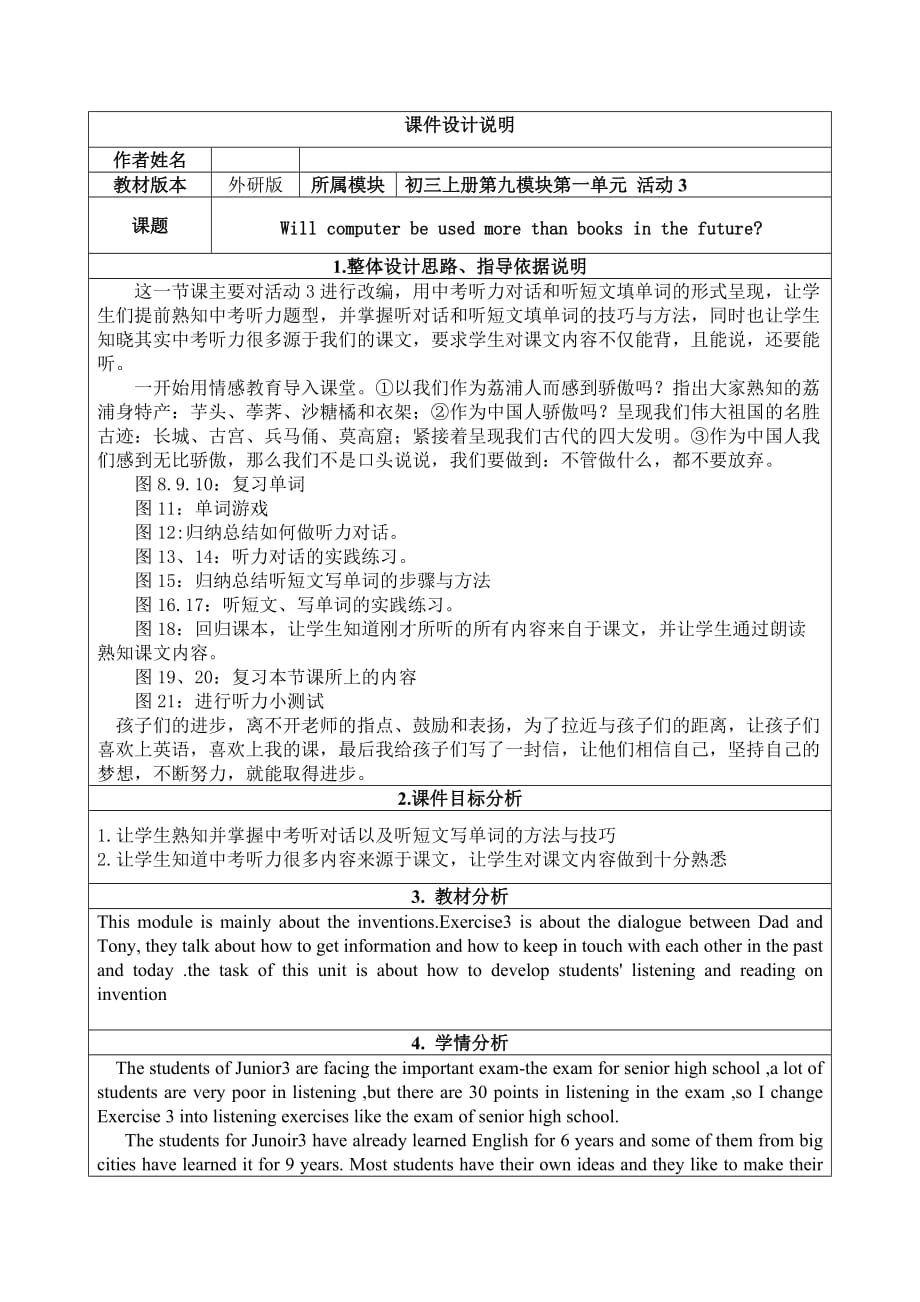《外研版九年級(jí)英語(yǔ)上冊(cè) Module 9 unit1 Will computers be used more than books in the future.教案》由會(huì)員分享�,可在線閱讀,更多相關(guān)《外研版九年級(jí)英語(yǔ)上冊(cè) Module 9 unit1 Will computers be used more than books in the future.教案(4頁(yè)珍藏版)》請(qǐng)?jiān)谘b配圖網(wǎng)上搜索�。
1�、
課件設(shè)計(jì)說(shuō)明
作者姓名
教材版本
外研版
所屬模塊
初三上冊(cè)第九模塊第一單元 活動(dòng)3
課題
Will computer be used more than books in the future?
1.整體設(shè)計(jì)思路、指導(dǎo)依據(jù)說(shuō)明
這一節(jié)課主要對(duì)活動(dòng)3進(jìn)行改編�,用中考聽(tīng)力對(duì)話(huà)和聽(tīng)短文填單詞的形式呈現(xiàn),讓學(xué)生們提前熟知中考聽(tīng)力題型�,并掌握聽(tīng)對(duì)話(huà)和聽(tīng)短文填單詞的技巧與方法,同時(shí)也讓學(xué)生知曉其實(shí)中考聽(tīng)力很多源于我們的課文�,要求學(xué)生對(duì)課文內(nèi)容不僅能背,且能說(shuō)�,還要能聽(tīng)。
一開(kāi)始用情感教育導(dǎo)入課堂�。①以我們作為荔浦人而感到驕傲嗎?指出大家熟知的荔浦身特產(chǎn):芋頭�、荸薺、沙糖橘
2、和衣架�;②作為中國(guó)人驕傲嗎?呈現(xiàn)我們偉大祖國(guó)的名勝古跡:長(zhǎng)城�、古宮、兵馬俑�、莫高窟;緊接著呈現(xiàn)我們古代的四大發(fā)明�。③作為中國(guó)人我們感到無(wú)比驕傲,那么我們不是口頭說(shuō)說(shuō)�,我們要做到:不管做什么,都不要放棄�。
圖8.9.10:復(fù)習(xí)單詞
圖11:?jiǎn)卧~游戲
圖12:歸納總結(jié)如何做聽(tīng)力對(duì)話(huà)。
圖13�、14:聽(tīng)力對(duì)話(huà)的實(shí)踐練習(xí)。
圖15:歸納總結(jié)聽(tīng)短文寫(xiě)單詞的步驟與方法
圖16.17:聽(tīng)短文�、寫(xiě)單詞的實(shí)踐練習(xí)。
圖18:回歸課本�,讓學(xué)生知道剛才所聽(tīng)的所有內(nèi)容來(lái)自于課文,并讓學(xué)生通過(guò)朗讀熟知課文內(nèi)容�。
圖19、20:復(fù)習(xí)本節(jié)課所上的內(nèi)容
3�、 圖21:進(jìn)行聽(tīng)力小測(cè)試
孩子們的進(jìn)步,離不開(kāi)老師的指點(diǎn)�、鼓勵(lì)和表?yè)P(yáng),為了拉近與孩子們的距離�,讓孩子們喜歡上英語(yǔ)�,喜歡上我的課�,最后我給孩子們寫(xiě)了一封信,讓他們相信自己�,堅(jiān)持自己的夢(mèng)想,不斷努力�,就能取得進(jìn)步。
2.課件目標(biāo)分析
1.讓學(xué)生熟知并掌握中考聽(tīng)對(duì)話(huà)以及聽(tīng)短文寫(xiě)單詞的方法與技巧
2.讓學(xué)生知道中考聽(tīng)力很多內(nèi)容來(lái)源于課文�,讓學(xué)生對(duì)課文內(nèi)容做到十分熟悉
3. 教材分析
This module is mainly about the inventions.Exercise3 is about the dialogue between Dad and Tony, they
4、 talk about how to get information and how to keep in touch with each other in the past and today .the task of this unit is about how to develop students listening and reading on invention
4. 學(xué)情分析
The students of Junior3 are facing the important exam-the exam for senior high school ,a lot of s
5�、tudents are very poor in listening ,but there are 30 points in listening in the exam ,so I change Exercise 3 into listening exercises like the exam of senior high school.
The students for Junoir3 have already learned English for 6 years and some of them from big cities have learned it for 9 year
6、s. Most students have their own ideas and they like to make their points. They are not content to the knowledge only from the textbooks , they want to get more information. They dont regard English as a rote memorization subject , they want to learn more knowledge and capacity during learning Englis
7�、h. Most of them know how to use computer to search for useful information as well.
5.課件腳本及設(shè)計(jì)意圖
環(huán)節(jié) 一: warming-up
Q1: Are you proud of being a person in Lipu? Why?
Q2: Are you proud of being a Chinese?
Q3: How many great inventions were there in the ancient China?
What are they?
Motto [m?t
8、??] 座右銘
Whatever I do ,I will never give up
Because I am a Chinese, I have a strong will.
Justification:
Q1: show some pictures of local products in Lipu to students, like taros, water chestnuts ,sugar oranges and coat hangers in order to make students realiz
9�、e they should be proud of being a person in Lipu and they should love their hometown.
Q2&Q3: Show some pictures of places of interest to students like the Great Wall ,the Palace Museum ,the Terracotta Army and Mogao Grottoes. And let them know there are four great inventions in ancient China. Every
10、one in China should be proud of a Chinese and love our homeland, and let students remember the motto "Whatever I do ,I will never give up . Because I am a Chinese ,I have a strong will."
環(huán)節(jié) 二:words review
Justification:
1.Let students read after the tape, correct their pronunciation.
2. A word
11�、game between students. One student speaks Chinese ,the other one speaks English in order to let them remember the words in a short time.
3.A word game between the teacher and all of the students. The teacher speaks Chinese and the students speaks English so that the teacher can know how many words
12�、and phrases the students have grasped.
環(huán)節(jié)三: Dialogue Listening
All of the listening materials are from the textbook: exercise3 on P72
Justification:
Let students know the steps and skills of how to do dialogue listening.
1.Ask some students on how to do dialogue listening
2.Give the ab
13、ove ways to do dialogue listening.
3.let students read the above methods
環(huán)節(jié)五:Listen and fill in the blanks
Justification:
Let students know the steps and skills of how to do listen and fill in the blanks.
1.Ask some students on how to do listen and fill in the blanks .
2.Give the above way
14�、s to do listen and fill in the blanks.
3.let students read the above methods
Justification:
Listening material 1
1.Ask students to underline the important words and phrases that are related to the answers and tell the reasons.
2.Listen for twice.
3.Check the answers. If some students didnt g
15、et the right answers, let them listen again.
Listening material 2
1.Ask students to underline the important words and phrases by themselves.
2.Listen for twice.
3.Check the answers.
①ask the students which word they have underlined.
②Let students tell the answer.
If the students didnt know
16�、the answers ,let them listen again.
環(huán)節(jié)六:Role play
1.Listen after the tape
2.Read in roles
Justification:
All of the listening materials are from the textbook: exercise3 on P72.
During Step III, students are familiar with the material by ear.
This step ,students open their books listen an
17、d read in order to be more familiar with the material and let them know a lot of listening materials are from our textbooks.
環(huán)節(jié)七:Listening skills of dialogues and short passages
Justification:
Review, consolidate and remember the Listening skills of dialogues and short passages
環(huán)節(jié)八:Have a listen
18�、ing test
Justification:
Have a test in order to know how many students have grasp the listening skills.
環(huán)節(jié)九:A letter to students
Justification:
Let students believe themselves they can get full marks in listening if they keep practicing.
6.課件設(shè)計(jì)特色
課件設(shè)計(jì)思路清晰,條理有序�,語(yǔ)言簡(jiǎn)潔明了�。除了實(shí)實(shí)在在的干貨(聽(tīng)力步驟與技巧)和有習(xí)題加強(qiáng)�、鞏固之外,并有最后聽(tīng)力小測(cè)試�,還有開(kāi)頭熱愛(ài)家鄉(xiāng)熱愛(ài)祖國(guó)的情感教育以及最后一封催人奮進(jìn)信的情感教育。
 外研版九年級(jí)英語(yǔ)上冊(cè) Module 9 unit1 Will computers be used more than books in the future.教案
外研版九年級(jí)英語(yǔ)上冊(cè) Module 9 unit1 Will computers be used more than books in the future.教案

